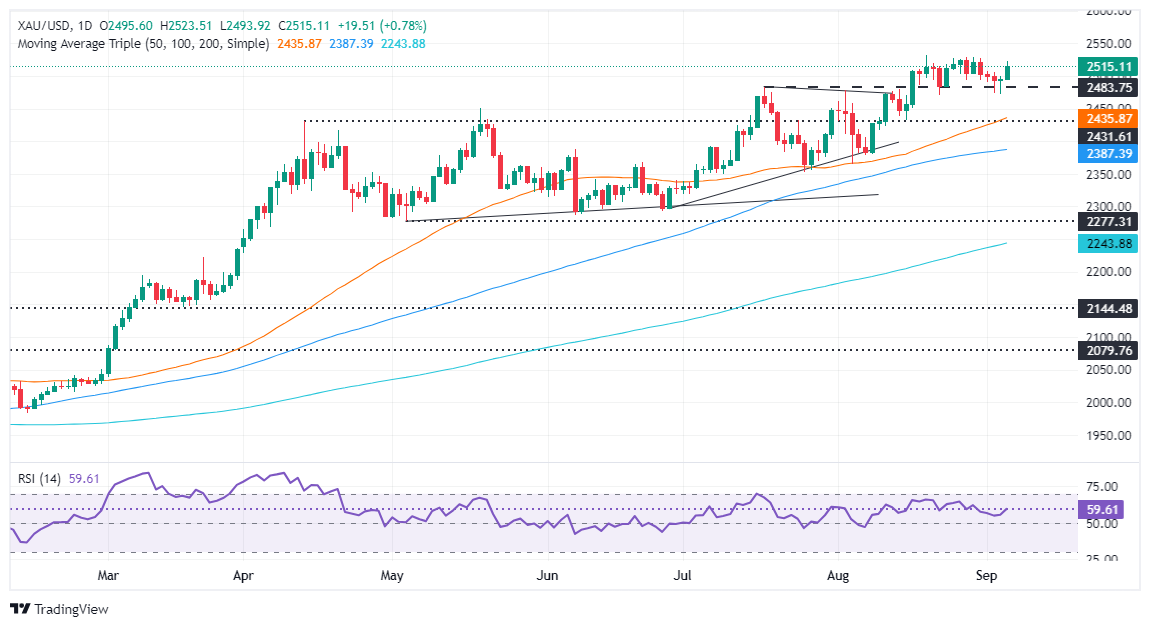Gold price jumps as markets bet on Fed easing

- Gold rises above $2,500, peaking at $2,523 before profit-taking ahead of key US economic data.
- Traders price in over 104 bps of Fed easing, expecting rate cuts to maintain labor market stability.
- Falling US Treasury yields and a weaker US Dollar support further upside in Gold prices.
Gold prices rallied sharply during the North American session, above the $2,500 figure on Thursday, yet remain shy of their daily peak of $2,523 as traders booked profits ahead of first-tier United States (US) data. At the time of writing, XAU/USD trades at $2,516, gaining over 0.80%.
In the early morning, US jobs data showed mixed readings, though it confirmed that the labor market is cooling, fueling speculation for a 50-basis-point (bps) interest rate cut by the Federal Reserve (Fed) in two weeks. On the other hand, the economy remains resilient as business activity in the services segment improved against projections of a slowdown.
However, Gold traders lifted the yellow metal above $2,500, as they priced in over 104 bps of Fed easing, according to the December 2024 Chicago Board of Trade (CBOT) fed funds futures contract.
What is almost certain is that the Fed may lower borrowing costs, according to San Francisco Fed President Mary Daly. She commented that the Fed needs to cut rates to keep the labor market healthy.
US Treasury yields fell after the data with the 10-year Treasury note down three basis points to 3.727%, undermining the buck. The US Dollar Index (DXY), a measure of the Greenback’s value against the other six currencies, tumbles over 0.21% to 101.05.
In the meantime, Gold traders are preparing for the release of the August Nonfarm Payrolls (NFP) report.
Daily digest market movers: Gold price surges ahead of US NFP data
- Figures of the ADP National Employment Change showed that private companies hired fewer people than expected, adding just 99K in August, well beneath the 145K expected and downwardly revised July figures.
- Initial Jobless Claims for the week ending August 31, hit 227K, below the 230K projected and the previous 232K.
- ISM Services Purchasing Managers Index (PMI), a measure of business activity, improved. The index hit 51.5 vs 51.4 in July and above the 51.1 projected by the consensus.
- August’s NFP figures are expected to rise from 114K to 163K, while the Unemployment Rate could dip, according to the consensus, from 4.3% to 4.2%.
Technical outlook: Gold price buyers reclaim $2,500
Gold prices had risen to new two-week highs above $2,500 before the NFP report's release. Price action shows buyers are gathering momentum as demonstrated by the Relative Strength Index (RSI), aiming for the upside in bullish territory.
That said, the XAU/USD path of least resistance is tilted to the upside, and it might challenge the year-to-date (YTD) high at $2,531. If surpassed, the next stop would be the psychological $2,550, followed by the $2,600 mark.
Conversely, if XAU/USD drops below $2,500, the next support would be the August 22 low at $2,470. Once cleared, the next demand zone would be the confluence of the April 12 high, which turned support, and the 50-day Simple Moving Average (SMA) at $2,435-$2,431.

Economic Indicator
Nonfarm Payrolls
The Nonfarm Payrolls release presents the number of new jobs created in the US during the previous month in all non-agricultural businesses; it is released by the US Bureau of Labor Statistics (BLS). The monthly changes in payrolls can be extremely volatile. The number is also subject to strong reviews, which can also trigger volatility in the Forex board. Generally speaking, a high reading is seen as bullish for the US Dollar (USD), while a low reading is seen as bearish, although previous months' reviews and the Unemployment Rate are as relevant as the headline figure. The market's reaction, therefore, depends on how the market assesses all the data contained in the BLS report as a whole.
Read more.
Next release: Fri Sep 06, 2024 12:30
Frequency: Monthly
Consensus: 160K
Previous: 114K
Source: US Bureau of Labor Statistics
Why it matters to traders?
America’s monthly jobs report is considered the most important economic indicator for forex traders. Released on the first Friday following the reported month, the change in the number of positions is closely correlated with the overall performance of the economy and is monitored by policymakers. Full employment is one of the Federal Reserve’s mandates and it considers developments in the labor market when setting its policies, thus impacting currencies. Despite several leading indicators shaping estimates, Nonfarm Payrolls tend to surprise markets and trigger substantial volatility. Actual figures beating the consensus tend to be USD bullish.





